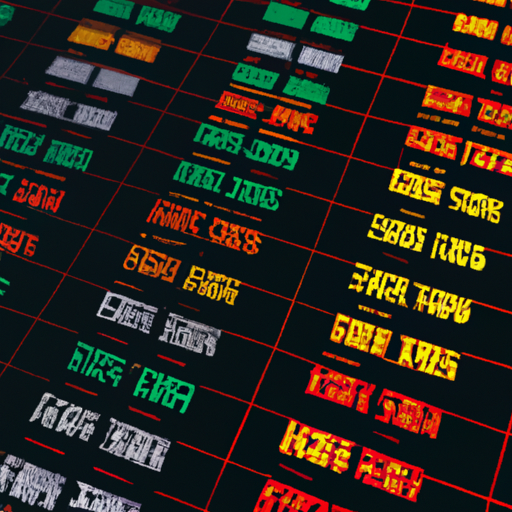-
Table of Contents
- Introduction
- Provenance Power and Media Metamorphosis: The New Face of Traditional Sectors in the Web3 Wave
- Retail Reimagined: The Impact of Web3 Wave on Traditional Sectors
- Token Transformation: The Role in Decentralized Dynamics of Web3 Wave
- Disruptive Ledger: The Key to Traditional Sectors Reboot in the Web3 Wave
- Web3 Wave: The Future of Rebooting Traditional Sectors
- Q&A
- Conclusion
“Web3 Wave: Revolutionizing Traditional Sectors with the Power of Decentralization.”
Introduction
Web3 Wave is a revolutionary concept that aims to reboot traditional sectors by integrating them with advanced blockchain technology. It represents the third generation of internet services, offering a decentralized platform where users have control over their own data. This new wave is set to transform various sectors including finance, healthcare, education, and more, by providing a more secure, private, and user-centric experience. It leverages the power of smart contracts, decentralized applications (DApps), and decentralized autonomous organizations (DAOs) to create a more equitable and efficient digital ecosystem.
Provenance Power and Media Metamorphosis: The New Face of Traditional Sectors in the Web3 Wave
The Web3 Wave is a transformative force that is rebooting traditional sectors, reshaping the way we interact with the digital world. This new era of the internet, characterized by decentralized networks and blockchain technology, is bringing about a profound shift in power dynamics and business models. Two sectors that are experiencing significant metamorphosis under the influence of Web3 are provenance and media.
Provenance, the ability to trace the origin and history of a product, has always been a crucial aspect of many industries, particularly in art, luxury goods, and food. However, the advent of Web3 is revolutionizing this space by introducing unprecedented levels of transparency and trust. Blockchain technology, the backbone of Web3, provides a decentralized, immutable ledger that can record every step of a product’s journey. This means that consumers can verify the authenticity and ethical sourcing of their purchases, empowering them to make more informed decisions.
For instance, in the art world, blockchain can be used to create a tamper-proof record of ownership, eliminating the risk of forgery and fraud. In the food industry, it can trace the entire supply chain, from farm to table, ensuring food safety and sustainability. This shift is not just beneficial for consumers; it also provides businesses with a competitive edge. By embracing blockchain, companies can enhance their brand reputation, foster customer loyalty, and tap into the growing market of conscious consumers.
The media industry is another sector undergoing a significant transformation in the Web3 Wave. Traditional media has long been dominated by a handful of powerful corporations, leading to concerns about censorship, bias, and lack of diversity. Web3, with its decentralized nature, promises to disrupt this status quo by democratizing content creation and distribution.
In the Web3 media landscape, anyone can become a content creator, and the audience has the power to directly reward their favorite creators through cryptocurrency payments. This peer-to-peer model eliminates the need for intermediaries, allowing for a more equitable distribution of revenue. Moreover, blockchain can also provide a solution to the pervasive issue of fake news. By recording every piece of content on a transparent, immutable ledger, it can ensure the traceability and accountability of information.
Furthermore, the rise of Non-Fungible Tokens (NFTs) is opening up new avenues for monetizing digital content. Artists, musicians, and writers can now tokenize their work, selling unique digital assets directly to their fans. This not only provides creators with a new revenue stream but also gives them greater control over their intellectual property.
In conclusion, the Web3 Wave is rebooting traditional sectors, ushering in a new era of transparency, trust, and democratization. By leveraging the power of blockchain, industries like provenance and media are undergoing a metamorphosis, evolving to meet the demands of the digital age. As we ride this wave, we can expect to see more sectors embracing the potential of Web3, reshaping our economy and society in profound ways. The future of the internet is decentralized, and it’s here to stay.
Retail Reimagined: The Impact of Web3 Wave on Traditional Sectors
The Web3 Wave, a term coined to describe the next generation of internet technologies, is poised to revolutionize traditional sectors, including retail. This new era of the internet, characterized by decentralized networks and powered by blockchain technology, is set to reboot traditional sectors, offering a more transparent, secure, and user-centric experience.
The retail sector, in particular, stands to gain significantly from the Web3 Wave. Traditional retail has been grappling with numerous challenges, including lack of transparency, data security issues, and limited customer engagement. However, the advent of Web3 technologies promises to address these issues, thereby reimagining the retail landscape.
At the heart of the Web3 Wave is blockchain technology, a decentralized ledger system that ensures transparency and security. In the retail sector, blockchain can be used to create a transparent supply chain, allowing consumers to trace the origin of products. This not only enhances consumer trust but also enables retailers to demonstrate their commitment to ethical sourcing and sustainability.
Moreover, blockchain technology can also address data security issues prevalent in the retail sector. Traditional retail relies heavily on centralized databases, which are vulnerable to hacking and data breaches. However, with blockchain, data is stored across a network of computers, making it virtually impossible for hackers to compromise. This ensures the security of sensitive customer data, thereby enhancing consumer trust.
Another significant impact of the Web3 Wave on the retail sector is the potential for enhanced customer engagement. Web3 technologies enable the creation of decentralized applications (dApps), which offer a more interactive and personalized user experience. For instance, retailers can use dApps to offer personalized recommendations, rewards, and discounts based on a customer’s shopping history and preferences. This not only enhances the shopping experience but also fosters customer loyalty.
Furthermore, the Web3 Wave also introduces the concept of tokenization, which can be leveraged to create loyalty programs. Retailers can issue their own tokens, which customers can earn and redeem for products or services. This not only incentivizes customer loyalty but also allows retailers to gain insights into customer behavior, thereby enabling them to tailor their offerings accordingly.
The Web3 Wave also paves the way for the integration of virtual and augmented reality technologies in the retail sector. These technologies can be used to create immersive shopping experiences, allowing customers to virtually try on clothes or view how furniture would look in their homes before making a purchase. This not only enhances the shopping experience but also reduces the likelihood of returns, thereby saving retailers money.
In conclusion, the Web3 Wave is set to reboot traditional sectors, with the retail sector standing to gain significantly. By leveraging blockchain technology, retailers can enhance transparency, ensure data security, and foster customer engagement. Moreover, the integration of dApps, tokenization, and virtual and augmented reality technologies promises to further revolutionize the retail landscape, offering a more interactive and personalized shopping experience. As such, retailers that embrace the Web3 Wave stand to gain a competitive edge in the increasingly digital and interconnected world.
Token Transformation: The Role in Decentralized Dynamics of Web3 Wave

The Web3 Wave, a term coined to describe the next generation of internet technologies, is set to revolutionize traditional sectors. This new wave is characterized by decentralized networks, blockchain technology, and the use of tokens. The Token Transformation, in particular, plays a pivotal role in the Decentralized Dynamics of the Web3 Wave, offering a reboot to traditional sectors.
Tokens, in the context of blockchain and cryptocurrency, are digital assets that can be transferred between network participants. They are used to incentivize and reward network participants, and they can represent a wide range of assets or utilities. The Token Transformation is a key aspect of the Web3 Wave because it enables a new form of value exchange that is decentralized, transparent, and secure.
In the traditional sectors, value exchange is often centralized and controlled by intermediaries. These intermediaries can be banks, governments, or other institutions that have the power to regulate and control the flow of value. This centralized system has its drawbacks, including inefficiencies, high costs, and the potential for misuse of power.
The Token Transformation brought about by the Web3 Wave offers a solution to these problems. By using blockchain technology, tokens can be used to create a decentralized system of value exchange. This system is not controlled by any single entity, but rather by the collective actions of all network participants. This decentralization brings about a number of benefits.
Firstly, it increases efficiency. Transactions can be processed quickly and cheaply, without the need for intermediaries. This can be particularly beneficial in sectors such as finance, where the traditional system of value exchange can be slow and expensive.
Secondly, it increases transparency. All transactions are recorded on the blockchain, a public ledger that can be viewed by anyone. This makes it difficult for any single entity to manipulate the system for their own gain.
Thirdly, it increases security. The decentralized nature of the system makes it highly resistant to hacking and fraud. This can be particularly beneficial in sectors such as healthcare, where the security of sensitive data is of utmost importance.
The Token Transformation is not just about creating a new system of value exchange, however. It also enables the creation of new business models and opportunities. For example, tokens can be used to create decentralized applications (dApps), which are applications that run on a blockchain network. These dApps can offer a wide range of services, from financial services to entertainment, and they can be monetized through the use of tokens.
In conclusion, the Token Transformation is a key aspect of the Web3 Wave that is set to reboot traditional sectors. By enabling a decentralized, transparent, and secure system of value exchange, tokens offer a solution to the problems of the traditional system. Furthermore, they enable the creation of new business models and opportunities, paving the way for a new era of innovation and growth. As the Web3 Wave continues to gain momentum, the role of tokens in this transformation will only become more significant.
Disruptive Ledger: The Key to Traditional Sectors Reboot in the Web3 Wave
The Web3 Wave, a term coined to describe the next generation of internet technologies, is poised to revolutionize traditional sectors. This new era of the internet, characterized by decentralized networks and powered by blockchain technology, is set to disrupt various industries, from finance to healthcare, education to entertainment. At the heart of this transformation is the Disruptive Ledger, a key tool in rebooting traditional sectors in the Web3 Wave.
The Disruptive Ledger, more commonly known as the blockchain, is a decentralized and distributed digital ledger that records transactions across multiple computers. It ensures that the record cannot be altered retroactively, without the alteration of all subsequent blocks. This technology is the backbone of cryptocurrencies like Bitcoin and Ethereum, but its potential extends far beyond digital currencies.
In the financial sector, blockchain technology is already making waves. It is eliminating the need for intermediaries in financial transactions, reducing costs, and increasing efficiency. Blockchain’s transparency and security features are also being leveraged to combat fraud and enhance trust in financial systems. Moreover, the advent of decentralized finance (DeFi) is democratizing access to financial services, enabling peer-to-peer transactions, and fostering financial inclusion.
In the healthcare sector, blockchain technology is being used to create secure, interoperable health records. This not only improves data security but also enhances patient privacy. Furthermore, blockchain can streamline administrative processes, reduce healthcare costs, and facilitate better health outcomes by enabling real-time access to patient data.
In the education sector, blockchain is being used to verify academic credentials, eliminating the need for manual verification and reducing the risk of credential fraud. It can also facilitate personalized learning by securely storing and sharing individual learning records.
In the entertainment industry, blockchain is disrupting traditional content distribution models. It is enabling artists to monetize their work directly, bypassing intermediaries, and ensuring fair compensation. Blockchain is also fostering transparency in royalty distribution and enhancing copyright protection.
The Disruptive Ledger is not just rebooting traditional sectors; it is also creating new ones. The rise of non-fungible tokens (NFTs) and decentralized autonomous organizations (DAOs) are prime examples of this. NFTs are revolutionizing the art world by providing a platform for digital artists to sell their work directly to consumers. DAOs, on the other hand, are redefining organizational structures by enabling decentralized decision-making and governance.
However, the transition to Web3 is not without challenges. Regulatory uncertainty, technological complexity, and scalability issues are some of the hurdles that need to be overcome. Moreover, there is a need for widespread education and awareness about blockchain technology to facilitate its adoption.
In conclusion, the Web3 Wave, powered by the Disruptive Ledger, is set to reboot traditional sectors. It is transforming the way we transact, interact, and operate, paving the way for a more decentralized, transparent, and efficient world. As we ride this wave, it is crucial to navigate the challenges and harness the potential of this transformative technology to create a better future.
Web3 Wave: The Future of Rebooting Traditional Sectors
The Web3 Wave, a term that has been gaining traction in recent years, refers to the third generation of internet services that leverage blockchain technology and decentralized networks. This new wave is not just about creating a more secure and private internet, but it’s also about rebooting traditional sectors and transforming them into more efficient, transparent, and user-centric entities.
The Web3 Wave is a significant departure from the current Web2 model, which is centralized and controlled by a few tech giants. In contrast, Web3 is decentralized, meaning that no single entity has control over the entire network. This decentralization brings about a host of benefits, including enhanced security, privacy, and user control.
One of the most significant impacts of the Web3 Wave is its potential to reboot traditional sectors. Industries such as finance, healthcare, education, and real estate, which have long been dominated by centralized entities, are ripe for disruption. The decentralized nature of Web3 allows for the creation of decentralized applications (dApps) that can provide services in a more transparent, efficient, and user-centric manner.
Take the finance sector, for example. The advent of decentralized finance (DeFi) is already shaking up the industry. DeFi applications are built on blockchain technology, allowing for the creation of financial services that are open to anyone, regardless of their location or financial status. This is a stark contrast to traditional financial services, which are often inaccessible to a large portion of the global population.
In the healthcare sector, the Web3 Wave could lead to the creation of decentralized health records, where patients have full control over their data. This not only enhances privacy but also allows for more personalized care. Similarly, in the education sector, blockchain technology could enable the creation of decentralized education platforms, where learners have control over their learning paths and credentials.
The real estate sector could also benefit from the Web3 Wave. Blockchain technology could enable the tokenization of real estate assets, making it possible for anyone to invest in real estate, regardless of their financial status. This could democratize the real estate investment process, making it more accessible and transparent.
However, the transition to Web3 is not without its challenges. Issues such as scalability, interoperability, and regulatory uncertainty need to be addressed. Moreover, there is a need for education and awareness about the benefits and potential risks of Web3 technologies.
Despite these challenges, the potential benefits of the Web3 Wave are too significant to ignore. As more and more industries begin to explore the possibilities of blockchain technology and decentralized networks, we are likely to see a significant shift in how traditional sectors operate.
In conclusion, the Web3 Wave represents a significant opportunity to reboot traditional sectors, making them more efficient, transparent, and user-centric. While there are challenges to overcome, the potential benefits are immense. As we move towards a more decentralized future, it’s clear that the Web3 Wave is not just a passing trend, but a fundamental shift in how we interact with the internet and each other.
Q&A
1. Question: What is the Web3 Wave?
Answer: The Web3 Wave refers to the third generation of internet services that leverage blockchain technology and decentralized networks. It aims to create a more user-centric web where users have control over their data and transactions.
2. Question: How is Web3 Wave rebooting traditional sectors?
Answer: Web3 Wave is rebooting traditional sectors by introducing decentralization, transparency, and peer-to-peer interactions. It’s transforming sectors like finance, healthcare, and supply chain by enabling decentralized finance (DeFi), decentralized health records, and transparent supply chain management.
3. Question: What is the role of blockchain in Web3 Wave?
Answer: Blockchain plays a crucial role in Web3 Wave as it provides the underlying technology for decentralization. It enables secure, transparent, and tamper-proof transactions, which are fundamental to the functioning of Web3 services.
4. Question: How does Web3 Wave impact the finance sector?
Answer: Web3 Wave impacts the finance sector through DeFi, which offers financial services on a decentralized platform. It eliminates intermediaries, reduces costs, and increases accessibility, allowing anyone with an internet connection to access financial services.
5. Question: What are the potential challenges of Web3 Wave?
Answer: Potential challenges of Web3 Wave include scalability issues, regulatory uncertainties, and security concerns. As the technology is still in its early stages, it needs to overcome these challenges to achieve widespread adoption.
Conclusion
The Web3 Wave is set to revolutionize traditional sectors by introducing decentralized, transparent, and user-centric systems. It will disrupt existing models by enabling peer-to-peer interactions, promoting data privacy, and allowing users to have control over their digital assets. This new wave, powered by blockchain technology, will redefine the way businesses operate, leading to a more equitable and efficient digital economy.



